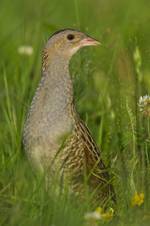Loudly and secretely
The Corncrake (Crex crex L.) is a rail species and thus is closely related to water rail and even the crane. In the vernacular, it is also called the meadow snorer. It is rarely seen because it lives hidden in not too dense, fresh meadows and wasteland. As all species of rails it relies in its camofluage and its fast legs as long as possible. Only very reluctantly does it fly, but when the corncrakes arrive in May from the African wintering areas the males nightly "krrg" "krrg" calls cannot be missed.
The males occupy a "call territory" where the nest will also be located. The females breed alone and even chase away the males during the laying period. The females care for the young and then can remate for a second brood. The corncrake partnership therefore lasts only for a short time. Males may mate several times within a breeding season.
Like a flea in the fur through the grass

Pristine breeding habitats of the corncrake are treeless sites with low vegetation, such as the river valleys fens in Central Europe. Today, the presence of the Corncrake is closely related to agricultural practice. Besides fen and flood plains with sparse vegetation, corncrake can also find enough space in large, fresh seams of grain fields. Fallow lands are also preferred breeding grounds. In an abandoned grasland after 1 to 2 years the vegetation cover usually becomes too dense for the corncrake and the site is not suitable.
In farmed locations it's the mowing, which ensures that the vegetation is not too dense and remains loosely structured. Then the birds can move like fleas in fur without resistance through the gras. Of great importance is the timing and the way of mowing. Only very late in the year (i.e. earliest from August on), mown meadows ensure that corncrakes can raise their offspring successfully. Because Corncrakes do not fly up in danger but flee on foot for as long as possible, a fast harvester with a large working width is a great danger.
Conservation efforts
To safeguard or restore the habitats of the Corn Crake we try to create open, treeless sedge marshlands. On the other hand, agricultural management should be transformed into a management more suitable for the Corn Crake. For instance, there are positive experiences concerning a special mowing technique in the National Park "Unteres Odertal", because late mowing can not always be realized. They introduced mowing in strips and at different times with some additional refuge strips, where adult and juvenile Corn Crakes can hide and find food.






